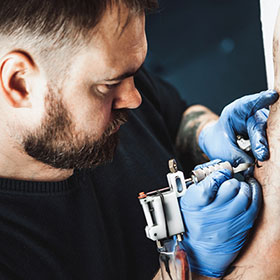Yes, hip tattoos can hurt. Pain levels vary from person to person.
The hip area has both muscle and bone, affecting the tattoo experience. Getting a tattoo is a big decision. Understanding the pain involved is crucial. The hip is a popular spot for tattoos. But, it can be sensitive. The skin here is thinner, and there are many nerve endings.
This can make the process painful for some. Others may feel less discomfort. Pain tolerance differs. So, it’s important to know what to expect. Preparing mentally and physically can help. In this blog, we will explore the factors that influence pain levels. We will also share tips to manage the pain. This will help you decide if a hip tattoo is right for you.
Introduction To Hip Tattoos
Hip tattoos are very popular. Many people love their unique look. Celebrities often get hip tattoos. This makes them even more trendy. Both men and women choose hip tattoos. They can be small or large. Some people prefer simple designs. Others like detailed art. The hip area offers a lot of space. This allows for creative designs. You can hide them easily. This makes them a good choice for many.
Hip tattoos can have deep meanings. They often represent personal beliefs. Some choose symbols of strength. Others pick designs showing love or memories. These tattoos can tell a story. They can honor loved ones. Many use them to show personal growth. A hip tattoo can be a bold statement. It can be a beautiful work of art. Each tattoo is unique to the person.
Factors Influencing Pain Levels
Hip tattoos can be painful. The level of discomfort varies due to skin sensitivity and bone proximity. Individual pain tolerance also plays a role.
Skin Sensitivity
Skin sensitivity plays a big role in tattoo pain. Some people have more sensitive skin. This can cause more pain. Sensitive skin areas may be more tender. This can make the tattoo process harder to handle. Skin type also matters. Dry skin can be more painful to tattoo.
Tattoo Placement
Tattoo placement affects pain. The hip area has many nerve endings. This can make it hurt more. Bones near the skin can also cause more pain. Areas with more fat and muscle hurt less. The hip has both, but the bone is close to the skin. This can make the pain feel sharper.
Pain Tolerance And Individual Variation
Everyone has a different pain threshold. Some people feel pain more than others. Pain tolerance depends on many factors. These factors include stress levels and mood. A person’s mental state can affect pain perception. Some days, pain feels less intense. Other days, it feels stronger.
Past tattoo experiences can influence pain. If you have many tattoos, you might find it easier. First-time tattooing can be more painful. Knowing what to expect helps. Familiarity with the process reduces anxiety. Less anxiety often means less pain. Previous tattoos can make hip tattoos hurt less.
Tattoo Techniques And Pain
Different needle types affect tattoo pain. Liner needles are thin and precise. They create sharp lines. Shader needles are thicker. They fill in areas. Magnum needles are used for shading. They cover large areas. Each type has a different pain level.
There are various tattooing methods. Hand-poked tattoos are done manually. They use a single needle. This method is slower but less painful. Machine tattoos use an electric device. They are faster but can be more painful. Each method has pros and cons.
Pain Management Strategies
Topical anesthetics can help numb the skin. These creams or gels are applied before the tattooing starts. They need time to work, so apply them early. They can reduce the pain felt during the tattoo session. This makes the process more comfortable. Always ask your tattoo artist for advice on using these products. Some people may have allergies to certain ingredients. Always do a patch test first.
Breathing techniques help manage pain. Deep breaths can calm the body. Slowly inhale through the nose. Hold the breath for a few seconds. Then, exhale slowly through the mouth. This helps to relax the muscles. It also distracts the mind from the pain. Focusing on breathing can make the tattoo process easier. Practice these techniques before the tattoo session. It can make a big difference.
Aftercare And Pain Relief
Keep your tattoo clean. Gently wash it with mild soap and water. Pat it dry with a clean towel. Apply a thin layer of healing ointment. Avoid heavy creams. They can clog your pores.
Wear loose clothes. This helps the tattoo breathe. It also prevents rubbing. Don’t scratch or pick at it. This can cause infections. Let it heal naturally.
Expect some redness and swelling. This is normal. It should go down in a few days. The tattoo may scab. Do not pick the scabs. They protect your skin while it heals.
Stay out of the sun. Sun exposure can fade your tattoo. Use sunscreen once it’s healed. Drink plenty of water. Hydrated skin heals faster.
Testimonials And Personal Stories
Many share their hip tattoo stories, noting a mix of pain and beauty. Personal experiences can vary widely, so it’s best to understand different perspectives.
First-time Experiences
Many first-timers say hip tattoos hurt. The skin is thin and sensitive. Pain varies for each person. Some feel a sharp sting. Others feel a dull ache. Breathing deeply helps some people cope. A few people even fall asleep during the session. It is important to stay calm and relaxed. Drink water and eat well before the appointment. These steps can make the process easier.
Veteran Insights
Veteran tattoo enthusiasts share mixed stories. Some say hip tattoos are very painful. Others say the pain is manageable. They recommend taking breaks if needed. Listening to music can help distract from the pain. Wearing comfortable clothes is also important. Loose clothing avoids rubbing on the fresh tattoo. Trusting your tattoo artist is key. A good artist will make the experience smoother.
Consulting A Professional
Consulting a professional can help assess the pain level for hip tattoos. Pain varies based on individual pain tolerance and tattoo placement. Professional advice ensures better preparation and realistic expectations.
Choosing The Right Artist
Finding a skilled tattoo artist is key. Look for someone with experience in hip tattoos. Check their portfolio. Read reviews. Ask friends for recommendations. Schedule a consultation. Discuss your design ideas. Ensure you feel comfortable. A good artist listens to your needs. They provide advice on placement and size. They also follow strict hygiene practices.
Preparation Tips
Prepare your body for the tattoo. Stay hydrated. Eat a healthy meal before your appointment. Wear loose clothing. This helps the artist access your hip easily. Avoid alcohol and drugs before the session. They can thin your blood. This makes the tattoo process harder. Bring something to distract you. Music or a book can help. Relax and stay calm. Your artist will guide you through the process.
Conclusion
Deciding to get a hip tattoo is a personal choice. Pain levels vary for everyone. Some feel mild discomfort; others find it intense. Proper preparation helps manage the pain. Choose an experienced tattoo artist. Follow aftercare instructions to ease healing.
Remember, beauty often involves some pain. A hip tattoo can be a meaningful and beautiful addition to your body art. Consider your pain tolerance and take the plunge if it feels right. Happy tattooing!

